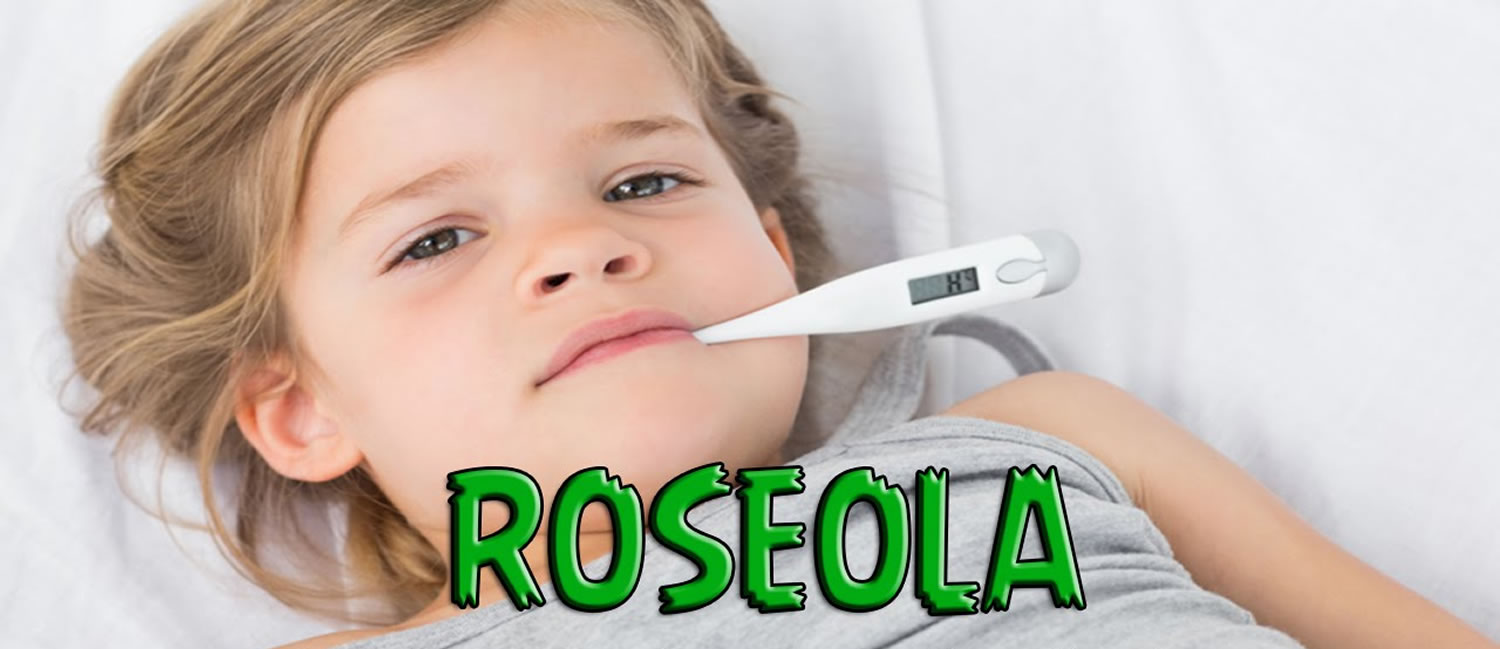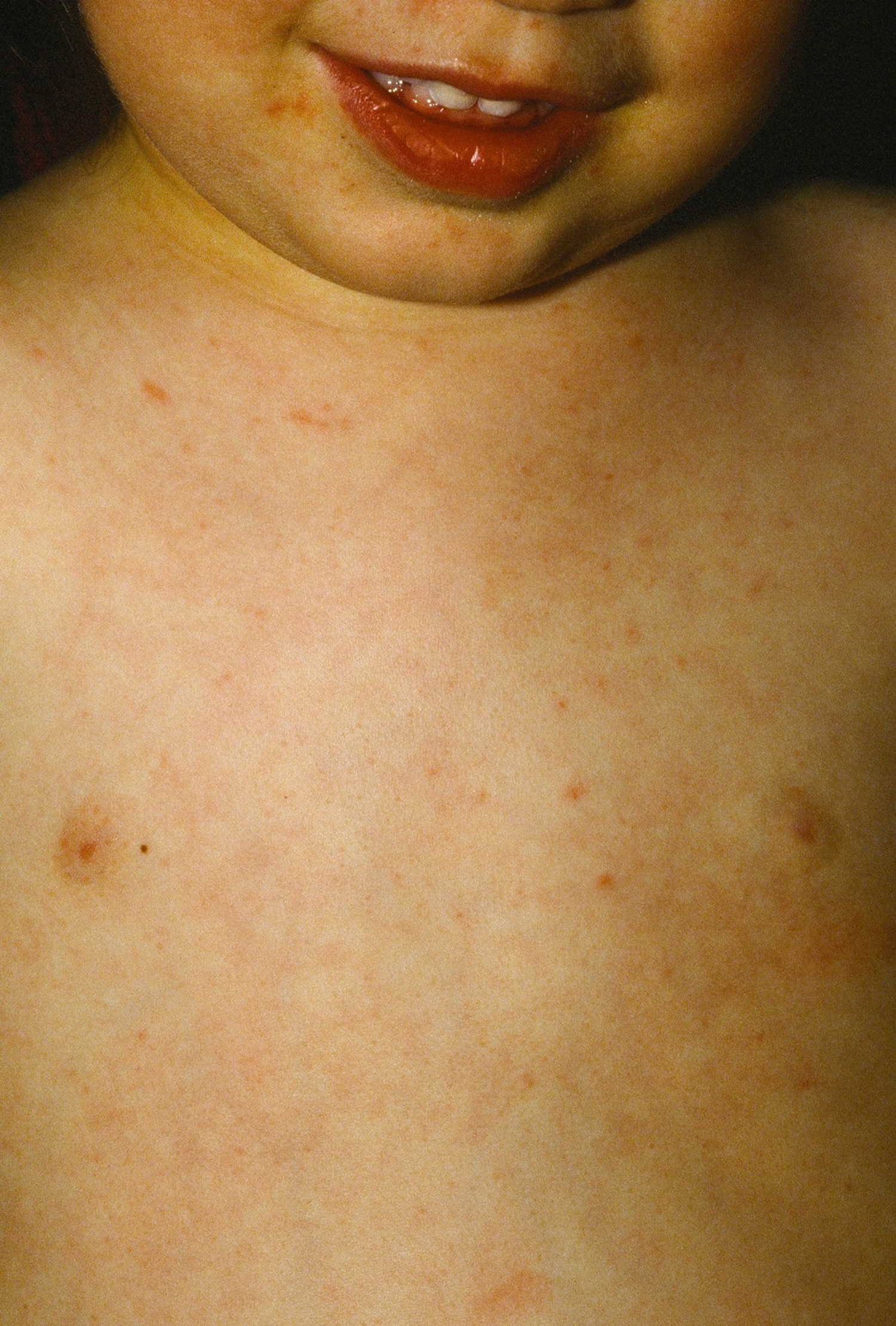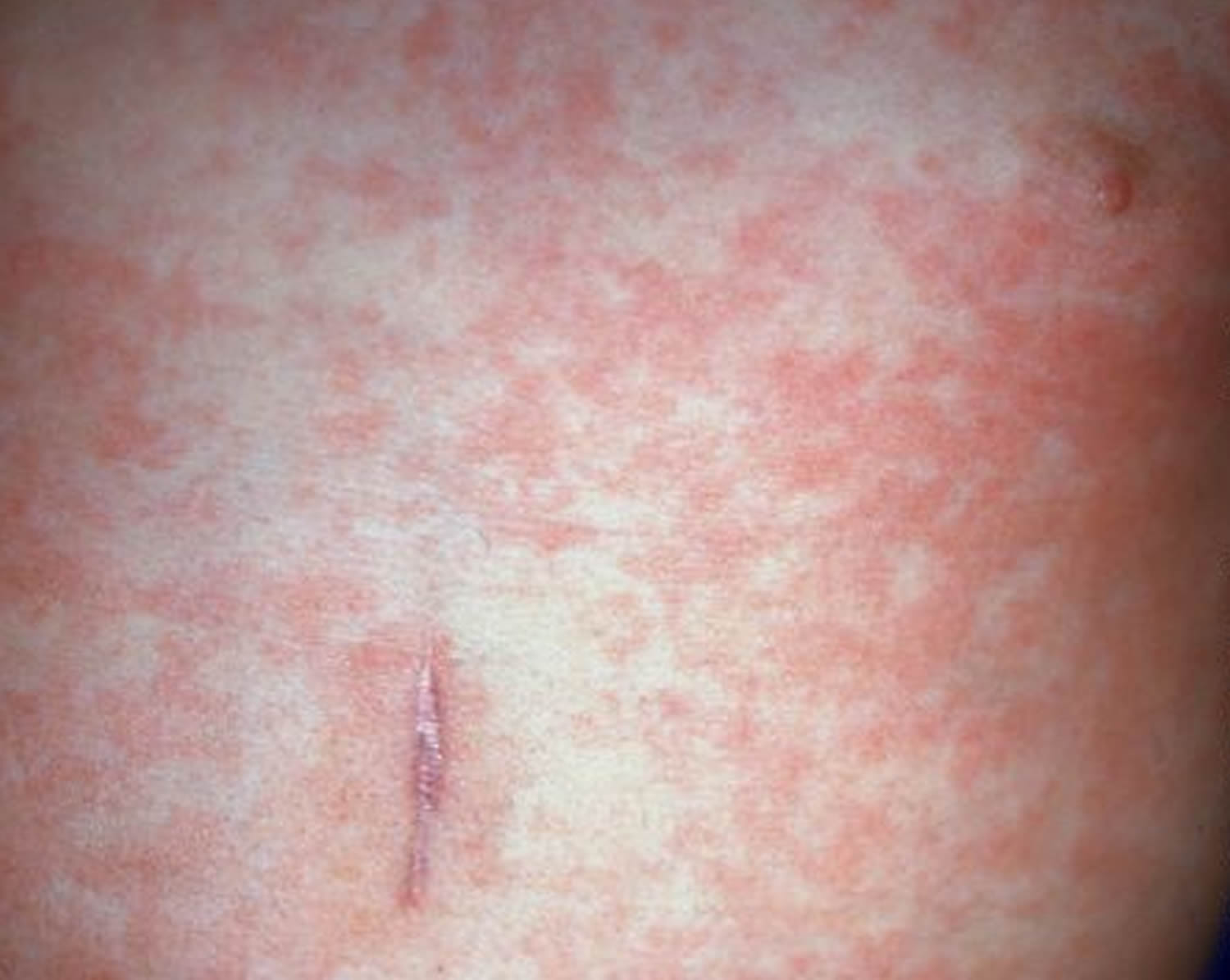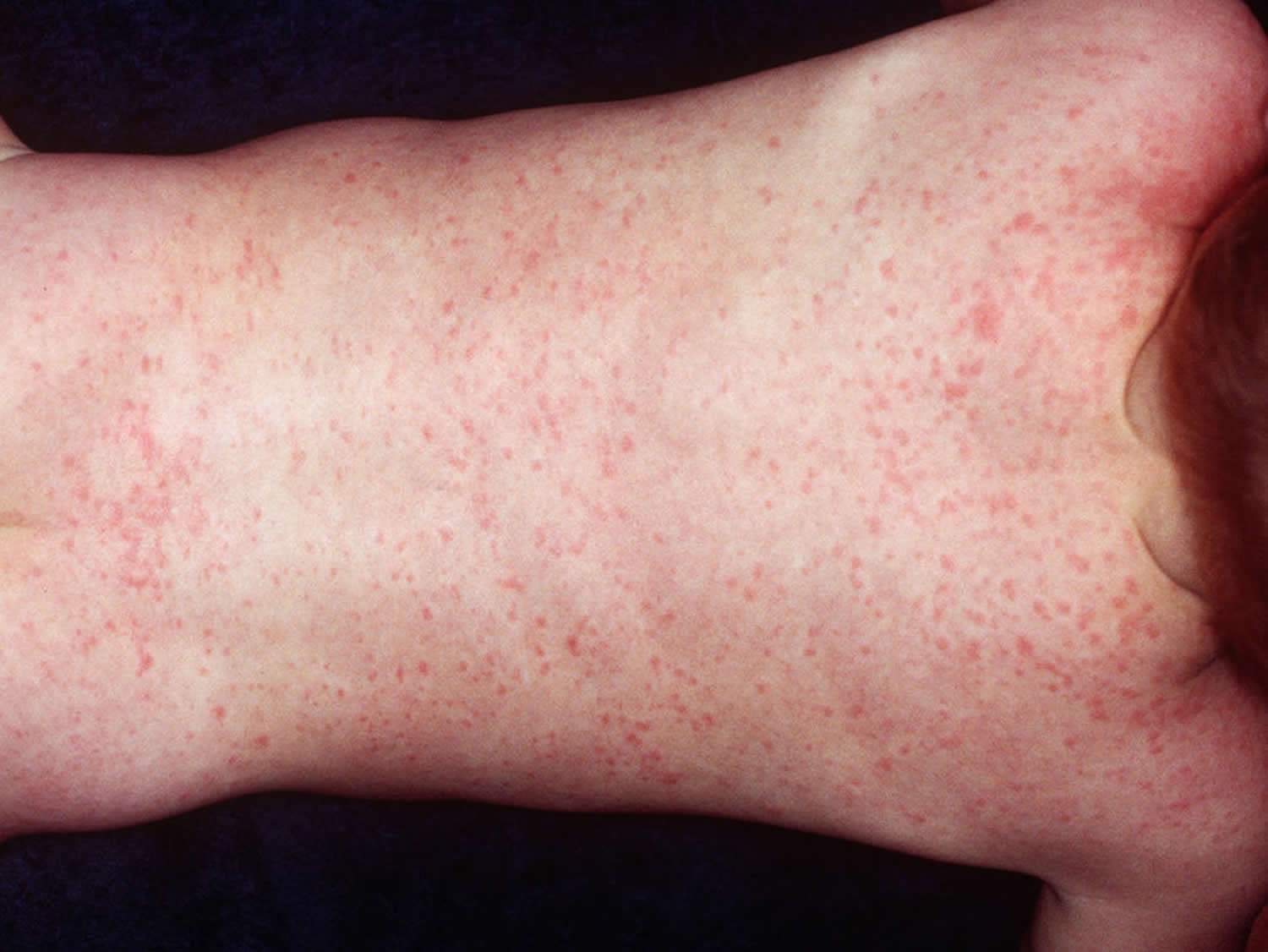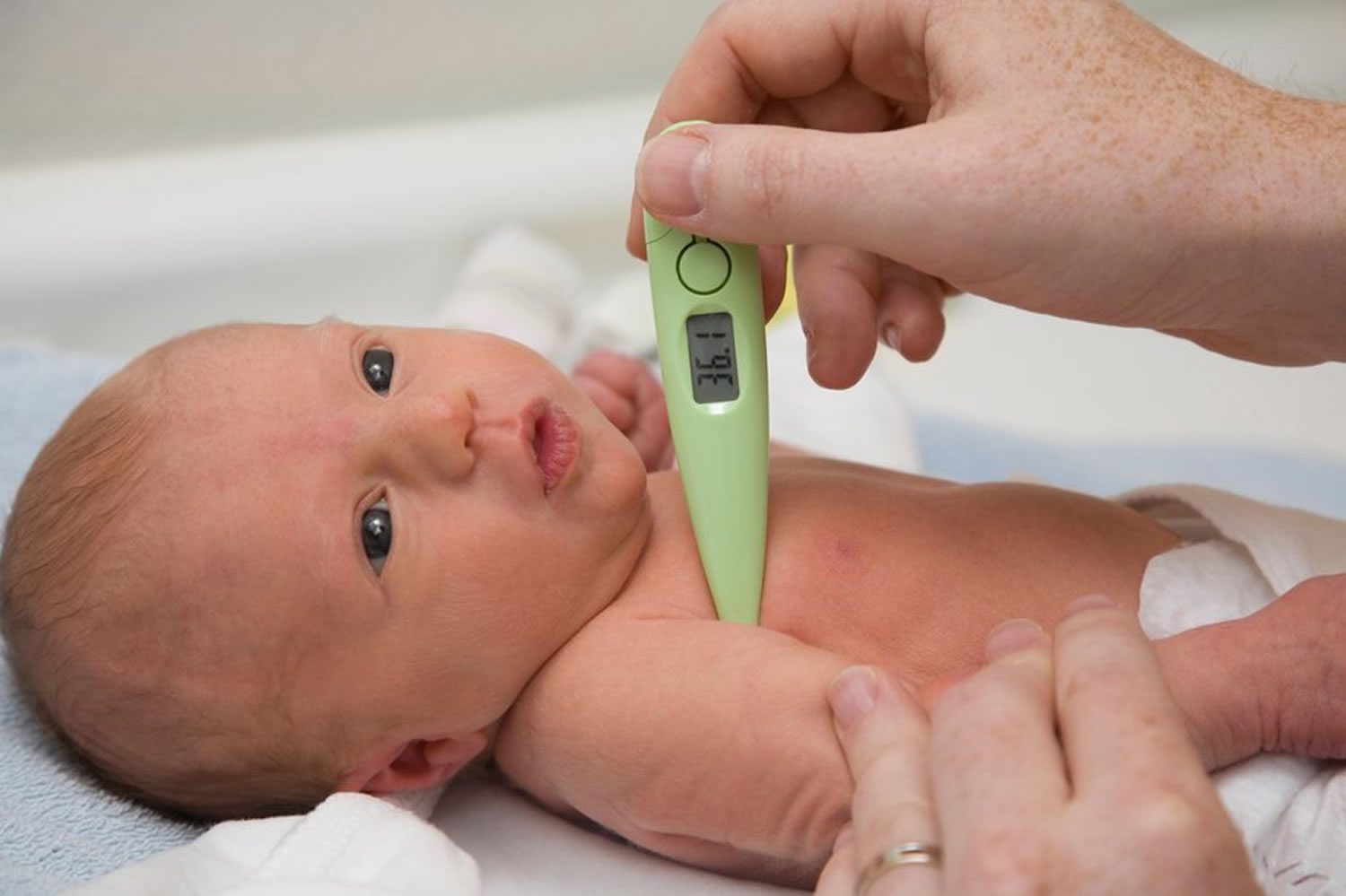Contents
What is roseola
Roseola, also known as sixth disease, exanthem subitum and roseola infantum, is a mild illness that mainly affects children that will go away on its own. Roseola is caused by two strains of herpes virus – human herpes virus type 6B (HHV-6B) and possibly type 7 (HHV-7). These herpes viruses have only been identified in recent years and scientists are still learning about the full range of diseases caused by them. Roseola is characterized by high fever lasting for 3–5 days, runny nose, irritability and tiredness. As the fever subsides a rash (exanthem) may appear on the face, neck and body. The roseola rash usually lasts 1–2 days, or it may go away more quickly.
Roseola is most commonly seen in children between 6 months and 3 years of age. Substances from the mother’s immune system (maternal antibodies) protect the child from getting roseola before the age of 6 months; however, it can occur in children between the ages of 3 months to 4 years. Most children (86%) will have had roseola by the age of 1 year. Roseola is rarely seen in adults, as infection during childhood probably confers lifelong immunity to the disease. Repeat attacks have been known to occur but are not common.
Roseola is spread from person to person via saliva of asymptomatic family members. The incubation period for roseola is approximately 9–10 days after exposure.
There is no way to prevent roseola from spreading because it is contagious before any symptoms appear.
Roseola goes away without any treatment. However, you might:
- Control your child’s fever with acetaminophen (Tylenol®) or ibuprofen and cool sponge baths. (Note: Do not use very cold water, ice, or alcohol rubs.)
- Encourage your child to drink fluids to avoid dehydration.
Note: Never give a child aspirin. It can trigger Reye’s syndrome, a rare but potentially fatal disorder.
Seek immediate medical care
Your child could have a convulsion (febrile seizure) if his or her fever becomes high or spikes quickly. However, usually by the time you notice your child’s high temperature, the threat of a possible seizure has already passed. If your child does have an unexplained seizure, seek medical care immediately.
See your child’s doctor
See your child’s doctor if:
- You’re concerned about your child’s symptoms
- You’re not sure what’s causing their symptoms
- Your child is under three months old and has a temperature of 101 °F (38 °C) or above
- Your child is between three and six months old and has a temperature of 102 °F (39 °C) or above
- Your child has roseola and the fever lasts more than seven days
- The rash doesn’t improve after three days
When to get emergency help
Call your local emergency number for an ambulance or go to your nearest accident and emergency (A&E) department immediately if your child:
- has a rash that doesn’t fade when you roll a glass over it – this could be a sign of meningitis
- has a seizure for the first time, even if they seem to recover
- has a seizure that lasts more than five minutes
- seems confused, drowsy or disorientated
- loses consciousness
Roseola doesn’t usually cause any serious problems, but it’s important to look out for these symptoms and get help if they occur.
Is roseola contagious?
Yes, and it spreads very easily among young children through saliva or respiratory droplets – like when an infected child sneezes or coughs, for example. It also spreads by fecal-oral contact, such as when an infected child doesn’t wash her hands after going to the bathroom. Because a child is contagious before she has symptoms, there’s often no way to avoid exposure.
It’s unclear exactly how long a child with roseola is contagious. They may be able to pass on the infection the whole time they’re ill, including before the rash develops.
Make sure all family members, especially those who take care of your child, wash their hands frequently. (This is an especially good idea in the fever stage because you don’t know that you’re dealing with roseola until you see the classic rash.)
To play it safe, keep your child home from daycare and school, and have her stay away from other people when she has a fever. After the fever has been gone for 24 hours, it’s safe for your child to be around others, even if the roseola rash appears.
How to stop roseola spreading
Roseola is spread in a similar way to the common cold – through coughs and sneezes, and contaminated objects or surfaces.
Roseola doesn’t spread very easily and you don’t need to keep your child away from nursery or school if they’re feeling well enough to attend.
If they’re unwell, keep them at home until they feel better, although there’s no need to wait until the last spot disappears.
The following may help stop the infection spreading to others:
- make sure you and your child wash your hands often
- ensure your child sneezes and coughs into tissues – throw away used tissues immediately and wash your hands
- clean surfaces regularly
- don’t share cups, plates, cutlery and kitchen utensils.
Figure 1. Roseola rash
How long does roseola rash last
Roseola rash usually lasts 1–2 days, or it may go away more quickly.
Roseola causes
The most common cause of roseola is the human herpes virus 6, but the cause also can be another herpes virus — human herpes virus 7.
Like other viral illnesses, such as a common cold, roseola spreads from person to person through contact with an infected person’s respiratory secretions or saliva. For example, a healthy child who shares a cup with a child who has roseola could contract the virus.
Roseola is contagious even if no rash is present. That means the condition can spread while an infected child has only a fever, even before it’s clear that the child has roseola. Watch for signs of roseola if your child has interacted with another child who has the illness.
Unlike chickenpox and other childhood viral illnesses that spread rapidly, roseola rarely results in a communitywide outbreak. The infection can occur at any time of the year.
Risk factors for roseola
Older infants are at greatest risk of acquiring roseola because they haven’t had time yet to develop their own antibodies against many viruses. While in the uterus, babies receive antibodies from their mothers that protect them as newborns from contracting infections, such as roseola. But this immunity decreases with time. The most common age for a child to contract roseola is between 6 and 15 months.
Roseola prevention
Because there’s no vaccine to prevent roseola, the best you can do to prevent the spread of roseola is to avoid exposing your child to an infected child. If your child is sick with roseola, keep him or her home and away from other children until the fever has broken.
Most people have antibodies to roseola by the time they’re of school age, making them immune to a second infection. Even so, if one household member contracts the virus, make sure that all family members wash their hands frequently to prevent spread of the virus to anyone who isn’t immune.
Adults who never contracted roseola as children can become infected later in life, though the disease tends to be mild in healthy adults. However, infected adults can pass the virus on to children.
Roseola complications
Complications are rare with roseola in most children. The most common complication is febrile seizures/convulsions that may occur in 5–15% of children. These are triggered by the high fevers of roseola and may be alarming when seen for the first time.
Signs of a febrile seizure include:
- Loss of consciousness
- Jerking or twitching movements in the arms, legs or face for 2 to 3 minutes
- Wet or soiled pants in an unconscious, toilet-trained child
- Irritability
Although frightening, fever-related seizures in otherwise healthy young children are generally short-lived and are rarely harmful. These seizures are brief and not dangerous. However, you should seek emergency care and have your child examined by a doctor if one happens.
Acute encephalitis, heptatis, myocarditis, hemophagocytic syndrome and infectious mononucleosis-like illness occur only very rarely.
Concerns for people with weak immune systems
Roseola is of greater concern in people whose immune systems are compromised, such as those who have recently received a bone marrow or organ transplant. They may contract a new case of roseola — or a previous infection may come back while their immune system is weakened. Because they have less resistance to viruses in general, immune-compromised people tend to develop more-severe cases of infection and have a harder time fighting off illness.
People with weak immune systems who contract roseola may experience potentially serious complications from the infection, such as pneumonia or encephalitis — a potentially life-threatening inflammation of the brain.
Reactivation of human herpes virus type 6B (HHV-6B) in immune suppressed patients or in association with drug hypersensitivity syndrome results in fever, rash, pneumonia, hepatitis, bone marrow suppression and encephalitis.
Roseola symptoms
If your child is exposed to someone with roseola and becomes infected with the roseola virus, it generally takes a week or two for signs and symptoms of infection to appear — if they appear at all. It’s possible to become infected with roseola, but have signs and symptoms too mild to be readily noticeable.
In many cases of roseola, the child appears well with few or no signs or symptoms.
Typical roseola infantum cases are characterized by the following:
- High fever, often up to 104 °F (40 °C) for 3–5 days
- Upper respiratory symptoms such as sore throat, cough, runny nose or congestion
- Your child may also develop swollen lymph nodes in his or her neck along with the fever.
- Irritability and tiredness
- Rash appears around days 3 to 5, as fever subsides
- Typically small rose-pink or red raised spots (2–5 mm in diameter) that blanch (turn white) when touched
- Some spots may be surrounded by a lighter halo of pale skin
- Mainly affects trunk and rarely spreads to involve neck, face, arms and legs
- Similar spots occur on soft palate and uvula (Nagayama spots)
- Non-itchy, painless and does not blister
- May fade within a few hours or persist for as long as 2 days
Other signs and symptoms of roseola may include:
- Irritability in infants and children
- Mild diarrhea
- Decreased appetite
- Swollen eyelids
In some cases, a child may be infected with the virus and never develop the rash. Less commonly, the roseola rash may appear without a preceding fever. In most cases, particularly if fever is low, the child is well. In about 5–15% of young children, high fevers may trigger febrile seizures.
How to take your baby’s temperature
A normal temperature in babies and children is about 97.5 °F (36.4 °C), but this can vary slightly. A fever is usually considered to be a temperature of 100.4 °F (38 °C) or above.
Your baby may have a fever if they:
- feel hotter than usual to the touch – on their forehead, back or stomach
- feel sweaty or clammy
- have flushed cheeks
If you think your baby has a fever, it’s best to check their temperature with a thermometer. This will help you work out whether you need to get medical advice.
Ideally, you need a digital thermometer to get a fast, accurate reading. You can buy these online or from pharmacies and most large supermarkets.
To take your child’s temperature:
- put the thermometer in your baby’s armpit – always use the thermometer in the armpit with children under five
- gently but firmly, hold their arm against their body to keep the thermometer in place for however long it says in the manufacturer’s instructions – usually about 15 seconds; some digital thermometers beep when they’re ready
- the display on the thermometer will then show your child’s temperature
Figure 2. How to take your baby’s temperature
How can I make sure the reading is accurate?
If you use a digital thermometer under your child’s armpit and follow the manufacturer’s instructions carefully, you should get an accurate reading.
There are a few things that can slightly alter the reading – for example, if your child has been:
- wrapped up tightly in a blanket
- in a very warm room
- very active
- cuddling a hot water bottle
- wearing a lot of clothes
- having a bath
If this is the case, allow your baby to cool down for a few minutes, but don’t let your baby get cold or shivery, then take his/her temperature again to see if there’s any change.
Other types of thermometer
You can buy other types of thermometer, but they may not be as accurate as a digital thermometer for taking a baby or small child’s temperature:
- ear (tympanic) thermometers – these allow you to take a temperature reading from the ear, and are quick but expensive; they can give misleading readings if you don’t put them in the ear correctly, which is more likely to happen with babies because their ear holes are so small
- strip-type thermometers – these are held against the forehead and aren’t an accurate way of taking a temperature: they show the temperature of the skin, rather than the body
You should never use an old-fashioned glass thermometer containing mercury. These can break, releasing small splinters of glass and highly poisonous mercury. They’re no longer used in hospitals and you can’t buy them in shops. If your child is exposed to mercury, get medical advice immediately.
Roseola diagnosis
Roseola can be difficult to diagnose because initial signs and symptoms are similar to those of other common childhood illnesses.
Because roseola is usually mild and self-limiting, diagnosis is usually solely based on the characteristic history and physical examination.
Some laboratories can confirm HHV-6 infection by serology or polymerase chain reaction (PCR).
Roseola treatment
There is no specific treatment for roseola. The disease is usually mild and self-limiting. Rest, maintaining fluid intake and acetaminophen (Tylenol, others) or ibuprofen (Advil, Motrin, others) for fever is all that is usually required. Don’t give your child paracetamol and ibuprofen at the same time. If one doesn’t work, you may want to try the other one later.
No treatment is necessary for the roseola rash, as it does not itch or hurt and fades spontaneously.
There’s no specific treatment for roseola, although some doctors may prescribe the antiviral medication ganciclovir (Cytovene) to treat the infection in people with weakened immunity. Antibiotics aren’t effective in treating viral illnesses, such as roseola.
Never give aspirin to children under 16 unless advised to by a doctor. Although aspirin is approved for use in children older than age 3, children and teenagers recovering from chickenpox or flu-like symptoms should never take aspirin. This is because aspirin has been linked to Reye’s syndrome, a rare but potentially life-threatening condition, in such children.
Home remedies
Like most viruses, roseola just needs to run its course. Once the fever subsides, your child should feel better soon. However, a fever can make your child uncomfortable. To treat your child’s fever at home, your doctor may recommend:
- Plenty of rest. Let your child rest in bed until the fever disappears.
- Plenty of fluids. Encourage your child to drink clear fluids, such as water, ginger ale, lemon-lime soda, clear broth, or an electrolyte rehydration solution (Pedialyte, others) or sports drinks, such as Gatorade or Powerade, to prevent dehydration. Remove the gas bubbles from carbonated fluids. You can do this by letting the carbonated beverage stand or by shaking, pouring or stirring the beverage. Removing the carbonation will mean having your child avoid the added discomfort of excess burping or intestinal gas that carbonated beverages may cause.
- Sponge baths. A lukewarm sponge bath or a cool washcloth applied to your child’s head can soothe the discomfort of a fever. However, avoid using ice, cold water, fans or cold baths. These may give the child unwanted chills.
There’s no specific treatment for the rash of roseola, which fades on its own in a short time.
